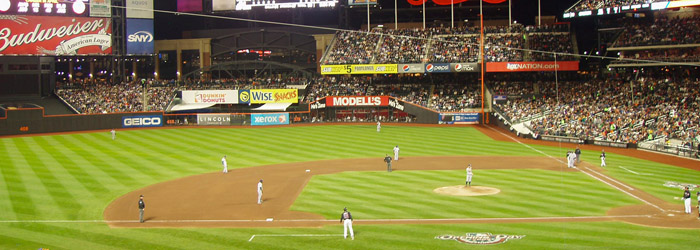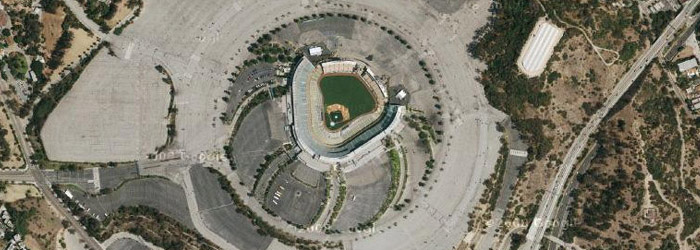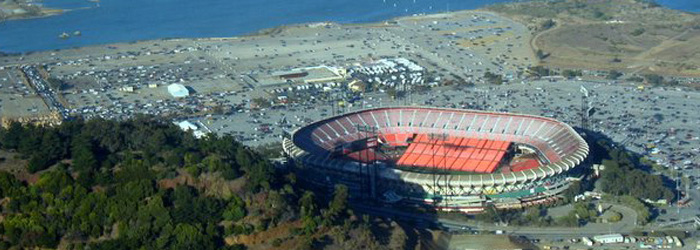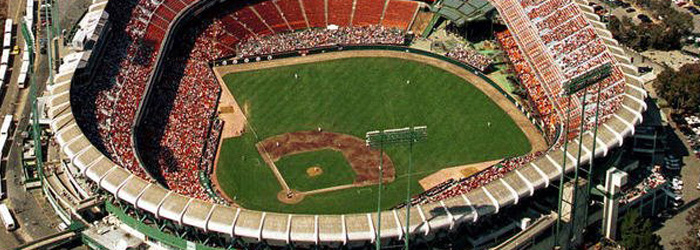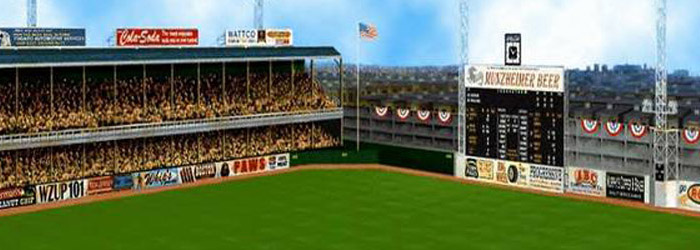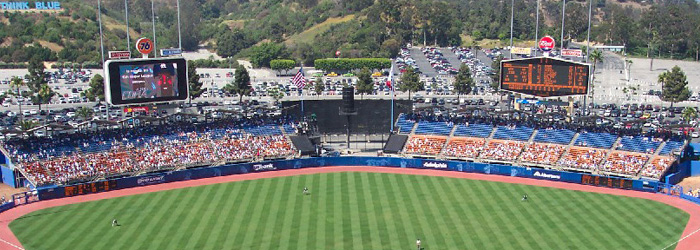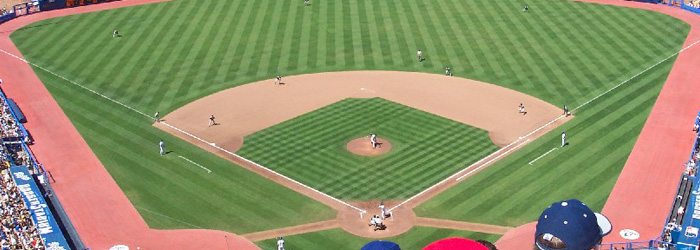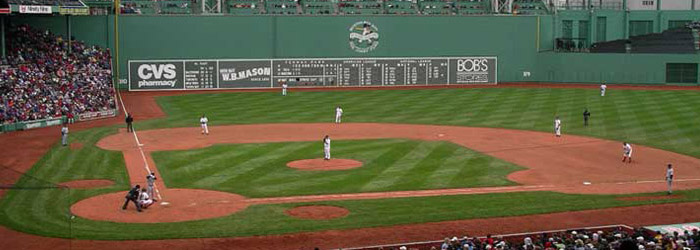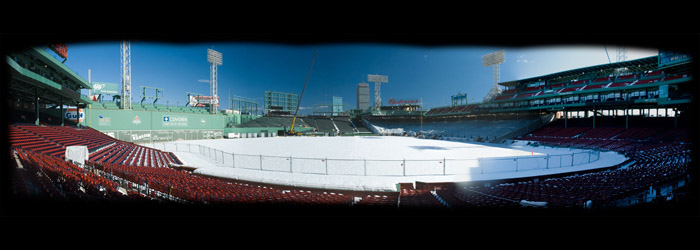Glossary
For more information on the terms described below, refer to the sources listed at the bottom of the page. To submit questions, comments, suggestions, or corrections please send e-mail here.
- Adjusted ERA (AERA)
- Earned-run average adjusted for league ERA and pitchers’ park factor. See tools for a detailed explanation.
- Adjusted OPS (AOPS)
- On-base percentage plus slugging average adjusted for league OBP and slugging average and batters’ park factor. See tools for a detailed explanation.
- Assists (A)
- A fielding statistic. Awarded to a pitcher on a strikeout from 1885 to 1888, but changed retroactively to reflect modern scoring rules.
- Assists per 162 Games (A/162)
- A fielding statistic. Calculated as assists times 162 divided by games. If innings played are available, a more accurate calculation is (assists times nine times 162) divided by innings played.
- At-Bats (AB)
- Included bases on balls in 1876 and 1887, but changed retroactively to reflect modern scoring rules. Included sacrifice hits from 1889 to 1893 and sacrifice flies from 1931 to 1938 and 1940 to 1953.
- Award Share (AS)
- The percentage of maximum votes received in award voting. See tools for a detailed explanation.
- Balks (Bk)
- Available for most seasons in major-league history from a combination of official and reconstructed sources.
- Baserunners per Nine Innings Pitched (BR/9)
- A pitching statistic. Calculated as (hits plus bases on balls plus hit batsmen) times nine divided by innings pitched. Hit batsmen are omitted if unavailable.
- Base on Balls (BB)
- Also known as a “walk“. A batter is awarded first base if a pitcher throws four pitches outside the strike zone. Counted as at-bats in 1876 and as at-bats and hits in 1887, but changed retroactively to reflect modern scoring rules. Until the present standard of four balls was permanently adopted in 1889, the number of balls required for the batter to be awarded first base varied: nine balls from 1876 to 1879, eight balls in 1880 and 1881, seven balls in 1882, 1883, and 1886, six balls in 1884 and 1885, and five balls in 1887 and 1888. Until 1887, a batter could specify a strike zone above or below the waist.
- Bases on Balls per Nine Innings Pitched (BB/9)
- A pitching statistic. Calculated as bases on balls times nine divided by innings pitched.
- Bases on Balls Percentage (BB%)
- A batting statistic. Calculated as bases on balls times 100 divided by (at-bats plus bases on balls).
- Batters Facing Pitcher (BFP)
- The sum of at-bats, bases on balls, hit batsmen, sacrifice hits, and sacrifice flies against a pitcher. Recorded by the National League since 1903 and the American League since 1908. Available for all seasons in major-league history from a combination of official and reconstructed sources.
- Batters’ Park Factor (BPF)
- An estimate of a ballpark’s effects on batting. See tools for a detailed explanation.
- Batting Average (Avg)
- Calculated as hits divided by at-bats.
- Batting Runs (BR)
- An estimate of the number of runs contributed beyond the league average adjusted for batters’ park factor. See tools for a detailed explanation.
- Blown Saves (BS)
- Charged to a relief pitcher who enters the game in a save opportunity and fails to protect the lead. See Saves.
- Caught Stealing (CS)
- Adopted officially by both leagues in 1920, but dropped by the National League after 1925 and not resumed until 1951. Compiled officially by the American League for every season since 1920 except 1927. Available for some seasons prior to 1920 from reconstructed sources.
- Complete Games (CG)
- Adopted officially by both leagues in 1920. Available for all seasons in major-league history from a combination of official and reconstructed sources.
- Double Plays (DP)
- A fielding statistic. Adopted officially by both leagues in 1922. Available for all seasons in major-league history from a combination of official and reconstructed sources.
- Doubles (2B)
- A base hit which allows a runner to reach second base.
- Earned Runs (ER)
- Adopted officially by the National League in 1912 and by the American League in 1913. For a few years after official adoption by both leagues, runs aided by stolen bases, hit batsmen, and wild pitches were frequently not counted as earned, and runs aided by a pitcher's own errors were often counted as earned. The modern scoring rules for designating runs as earned came into effect in 1917. Available for all seasons in major-league history from a combination of official and reconstructed sources.
- Earned-Run Average (ERA)
- Calculated as earned runs time nine divided by innings pitched. Adopted officially by the National League in 1912 and by the American League in 1913. See Earned Runs.
- Errors (E)
- A fielding statistic. Included wild pitches and hit batsmen for pitchers and passed balls for catchers until 1888, but changed retroactively to reflect modern scoring rules.
- Extra Bases (EB)
- Calculated as total bases minus hits.
- Extra-Base Hits (EBH)
- Calculated as doubles plus triples plus home runs.
- Fielding Percentage (Fld)
- A fielding statistic. Calculated as (putouts plus assists) divided by (assists plus errors plus putouts). A measure of a fielder’s sure-handedness but not his range.
- Games (G)
- Often not credited to a player entering a game as a pinch runner or defensive replacement prior to 1912 in the National League and 1907 in the American League, and inconsistently recorded until 1920.
- Games Behind (GB)
- Calculated as (leader’s wins minus team’s wins plus team’s losses minus leader’s losses) divided by two. Number of games a team finished behind the division or league leader.
- Games Finished (GF)
- Adopted officially by both leagues in 1920. Number of games finished by a pitcher in relief. Available for all seasons in major-league history from a combination of official and reconstructed sources.
- Games Relieved (GR)
- Calculated as games minus games started.
- Games Started (GS)
- Adopted officially by both leagues in 1920. Available for all seasons in major-league history from a combination of official and reconstructed sources.
- Grounded Into Double Play (GDP)
- Adopted officially by the National League in 1933 and by the American League in 1939. From 1933 to 1938 in the National League, charged as hit into double play (HDP) and included all double plays, not just groundballs, hit into by the batter.
- Hit by Pitch (HBP)
- Hit batsmen (HB) for pitchers. Adopted officially by the National League in 1917 and by the American League in 1920. Batters hit by a pitch were not entitled to first base until 1887 in the National League and 1884 in the American Association. Charged to a pitcher as an error until 1889, but changed retroactively to reflect modern scoring rules. Available for all seasons in major-league history from a combination of official and reconstructed sources.
- Hits (H)
- Included bases on balls in 1887, but changed retroactively to reflect modern scoring rules.
- Hits per Nine Innings Pitched (H/9)
- A pitching statistic. Calculated as hits times nine divided by innings pitched.
- Holds (Hld)
- Credited to a relief pitcher who enters a game in a save situation, records at least one out, and leaves the game never having relinquished the lead. May be credited to more than one pitcher in a game, but never to the winning pitcher, a pitcher earning a save, or the final pitcher of a game. Created by John Dewan and Mike Donnell in 1986. See Saves.
- Home Runs (HR)
- Prior to 1920, a game-winning hit was credited with only as many bases as required to drive in the winning run. Thus, if a ball went over the outfield fence and drove in the winning run from third base, it was only counted as a single. Prior to 1931, a batted ball was judged fair or foul on the basis of its location at the time it disappeared from the view of the umpires. Thus, if a ball went over the outfield fence in fair territory but left the view of the umpires in foul territory, it was a foul ball and not a home run. Also prior to 1931, any fair ball that bounced over the fence or into the stands was a home run.
- Home Runs per Nine Innings Pitched (HR/9)
- A pitching statistic. Calculated as home runs times nine divided by innings pitched.
- Home-Run Percentage (HR%)
- A batting statistic. Calculated as home runs times 100 divided by at-bats.
- Innings Pitched (IP)
- Usually included fractions of an inning from 1876 to 1919, but rounded off to the next highest inning from 1920 to 1982. Fractions of an inning have been reconstructed on a game-by-game basis from 1920 to 1982.
- Intentional Bases on Balls (IBB)
- Adopted officially by both leagues in 1955.
- Isolated Power (Iso)
- Calculated as (total bases minus hits) divided by at-bats, or slugging average minus batting average. A measure of a player’s ability to hit for power beyond the frequency of hits indicated by his batting average. Created by Branch Rickey and Allan Roth in the 1950s.
- Losses (L)
- After 1920, official scorers in both leagues were instructed to designate a winning and losing pitcher in every game. Official rules specifying the designation of a winning and losing pitcher were established in both leagues in 1950. Available for all seasons in major-league history from a combination of official and reconstructed sources.
- On-Base Percentage (OBP)
- Calculated as (hits plus bases on balls plus hit by pitch) divided by (at-bats plus bases on balls plus hit by pitch plus sacrifice flies), but calculated by Total Baseball without sacrifice flies in the denominator. Hit by pitch and sacrifice flies are omitted if unavailable. A measure of a player’s ability to reach base not only by hits, but by bases on balls and hit by pitch, too. Adopted officially by both leagues in 1984. Created by Branch Rickey and Allan Roth in the 1950s.
- On-Base Percentage Plus Slugging Average (OPS)
- A measure of a player’s ability both to reach base and to hit for power. For teams, correlates highly with runs scored.
- Opponents’ Batting Average (OAvg)
- See Batting Average.
- Opponents’ On-Base Percentage (OOBP)
- See On-Base Percentage.
- Outs Made (OM)
- Calculated as at-bats minus hits plus sacrifice hits plus sacrifice flies plus caught stealing plus grounded into double play. Sacrifice hits, sacrifice flies, caught stealing, and grounded into double play are omitted if unavailable.
- Passed Balls (PB)
- A fielding statistic for catchers. Adopted officially by the National League in the 1880s and by the American League in 1925. Charged as an error until 1888, but changed retroactively to reflect modern scoring rules. Available for all seasons in major-league history from a combination of official and reconstructed sources.
- Pitchers’ Park Factor (PPF)
- An estimate of a ballpark’s effects on pitching. See tools for a detailed explanation.
- Pitching Runs (PR)
- An estimate of the number of earned runs prevented beyond the league average adjusted for pitchers’ park factor. See tools for a detailed explanation.
- Plate Appearances (PA)
- Calculated as at-bats plus bases on balls plus hit by pitch plus sacrifice hits plus sacrifice flies. Hit by pitch, sacrifice hits, and sacrifice flies are omitted if unavailable.
- Putouts (PO)
- A fielding statistic. Awarded to a catcher on a strikeout.
- Pythagorean Losses (PL)
- The predicted losses based on runs and runs allowed. See tools for a detailed explanation.
- Pythagorean Winning Percentage (PPct)
- The predicted winning percentage based on runs and runs allowed. See tools for a detailed explanation.
- Pythagorean Wins (PW)
- The predicted wins based on runs and runs allowed. See tools for a detailed explanation.
- Range Factor (Rng)
- A fielding statistic. Calculated as (putouts plus assists) divided by games. The number of successful plays a fielder makes per game. If innings played are available, a more accurate calculation is (putouts plus assists) times nine divided by innings played.
- Reached Base (RB)
- Calculated as hits plus bases on balls plus hit by pitch. Hit by pitch are omitted if unavailable.
- Runs (R)
- Runs Batted In (RBI)
- Adopted officially by both leagues in 1920. From 1920 to 1939, included a runner scored even when the batter grounded into a double play. Available for all seasons in major-league history from a combination of official and reconstructed sources.
- Sacrifice Flies (SF)
- A flyball that scored a runner was counted as a sacrifice hit from 1908 to 1925 and in 1939. From 1926 to 1930, a sacrifice hit included any flyball that advanced a runner regardless of whether he scored. Flyballs were not counted as sacrifice hits and were charged as at-bats from 1931 to 1938 and from 1940 to 1953. A flyball that scored a runner was finally adopted as a separate, official category in 1954.
- Sacrifice Hits (SH)
- Recorded since 1889, but until 1893 included almost any out that advanced a runner. From 1894 to 1907, included only bunts used to advance a runner. Included flyballs that allowed a runner to score from 1908 to 1925 and in 1939. From 1926 to 1930, included any flyball that advanced a runner regardless of whether he scored. Charged as an at-bat from 1889 to 1893. Sacrifice hits allowed by pitchers were adopted officially by the National League in 1913 and by the American League in 1921.
- Saves (Sv)
- Until 1972, credited to a relief pitcher who finished a game his team won. From 1973 to 1974, credited to a relief pitcher who finished a game his team won with the tying or winning run on base or at bat. Since 1975, credited to a relief pitcher who pitches at least one inning protecting a lead of three or fewer runs to finish a game, finishes a game after entering it with the tying run on base, at bat, or on deck, or pitches at least the final three innings of a game effectively in the opinion of the official scorer. Never credited to the winning pitcher. Adopted officially by both leagues in 1969. Available for all seasons in major-league history from a combination of official and reconstructed sources. Created by Jerome Holtzman in the 1960s.
- Save Opportunities (Opp)
- Calculated as saves plus blown saves.
- Save Percentage (Sv%)
- Calculated as saves divided by save opportunities.
- Secondary Average (Sec)
- Calculated as (total bases minus hits plus bases on balls plus stolen bases) divided by at-bats. A measure of a player's offensive ability beyond his batting average, specifically his ability to hit for power, draw walks, and steal bases.
- Shutouts (Sh)
- Credited to a pitcher of a complete-game scoreless victory. Adopted officially by the National League in 1904 and the American League in 1908. Available for all seasons in major-league history from a combination of official and reconstructed sources.
- Singles (1B)
- Calculated as hits minus (doubles plus triples plus home runs).
- Slugging Average (Slg)
- Calculated as total bases divided by at-bats. A measure of a player’s ability to hit for power.
- Stolen Base Attempts (SBA)
- Calculated as stolen bases plus caught stealing.
- Stolen Bases (SB)
- Recorded since 1886. Included advancing extra bases on a hit or an out from 1886 to 1897.
- Stolen-Base Percentage (SB%)
- Calculated as stolen bases divided by (stolen bases plus caught stealing).
- Strike Zone
- The volume over home plate with which a pitch must intersect for the umpire to call the pitch a strike. Currently defined as the width of home plate (19") from a batter's knees to the numbers on his chest. In practice the strike zone can vary signicantly between umpires and leagues.
- Strikeouts (SO)
- Unavailable for batters from 1897 to 1909 in the National League, from 1901 to 1912 in the American League, from 1882 to 1888 in the American Association, for 1884 in the Union Association, and for 1914 and 1915 in the Federal League. Several factors have influenced strikeout totals over the years. In 1887, four strikes were required for an out. Until 1887, a batter could specify a strike zone above or below the waist. The present distance from home plate to the pitching rubber of 60 feet, six inches, was not established until 1893. Prior to 1901 in the National League and 1903 in the American League, foul balls were not counted as strikes.
- Strikeout Percentage (SO%)
- A batting statistic. Calculated as strikeouts times 100 divided by at-bats.
- Strikeouts per Nine Innings Pitched (SO/9)
- A pitching statistic. Calculated as strikeouts times nine divided by innings pitched.
- Successful Chances (SC)
- A fielding statistic. Calculated as assists plus putouts.
- Total Chances (TC)
- A fielding statistic. Calculated as assists plus errors plus putouts.
- Triples (3B)
- A base hit which allows a runner to reach third base.
- Walk
- See "Base on Balls"
- Wild Pitches (WP)
- Adopted officially by the National League in 1903 and by the American League in 1908. Charged to a pitcher as an error until 1888, but changed retroactively to reflect modern scoring rules. Available for most seasons in major-league history from a combination of official and reconstructed sources.
- Winning Percentage (WPct)
- Calculated as wins divided by (wins plus losses).
- Wins (W)
- After 1920, official scorers in both leagues were instructed to designate a winning and losing pitcher in every game. Official rules specifying the designation of a winning and losing pitcher were established in both leagues in 1950. Available for all seasons in major-league history from a combination of official and reconstructed sources.
The Bill James Historical Baseball Abstract, by Bill James (Villard 1986).
“A Brief History of the Home Run,” The Home Run Encyclopedia, edited by Bob McConnell and David Vincent (MacMillan1996).
“The Evolution of Baseball Statistics,” by Neil Munro, STATS All-Time Major League Handbook, edited by Bill James, John Dewan, Neil Munro, and Don Zminda (STATS 1998), and STATS All-Time Baseball Sourcebook, edited by Bill James, John Dewan, Neil Munro, Don Zminda, and Jim Callis (STATS1998).
Glossary, STATS Major League Handbook, edited by STATS (STATS 1999).
Glossary, Total Baseball, edited by John Thorn, Pete Palmer, Michael Gershman, and David Pietrusza (Total Sports 1999).
The Hidden Game of Baseball, by John Thorn and Pete Palmer with David Reuther (Doubleday1984).
